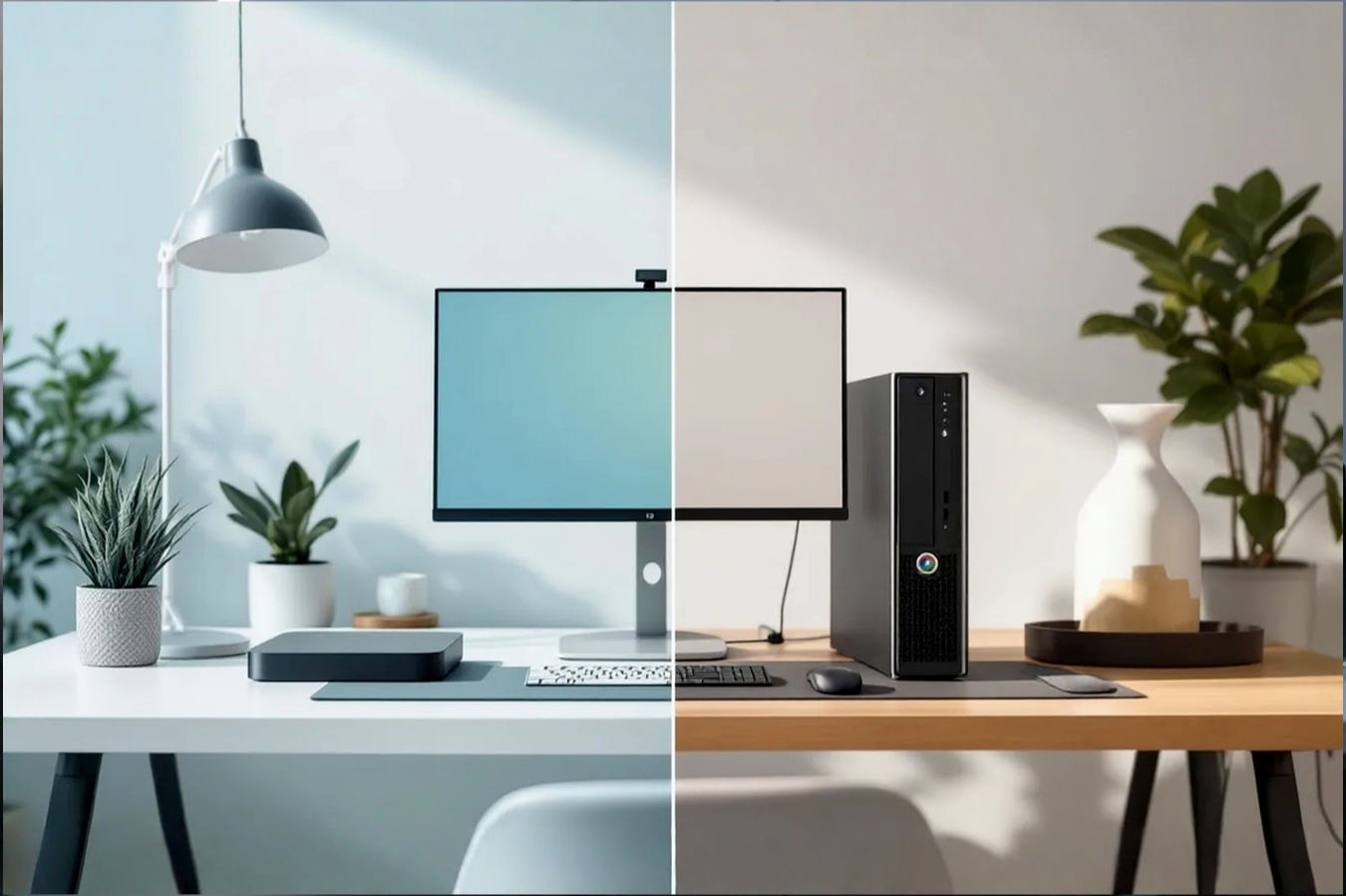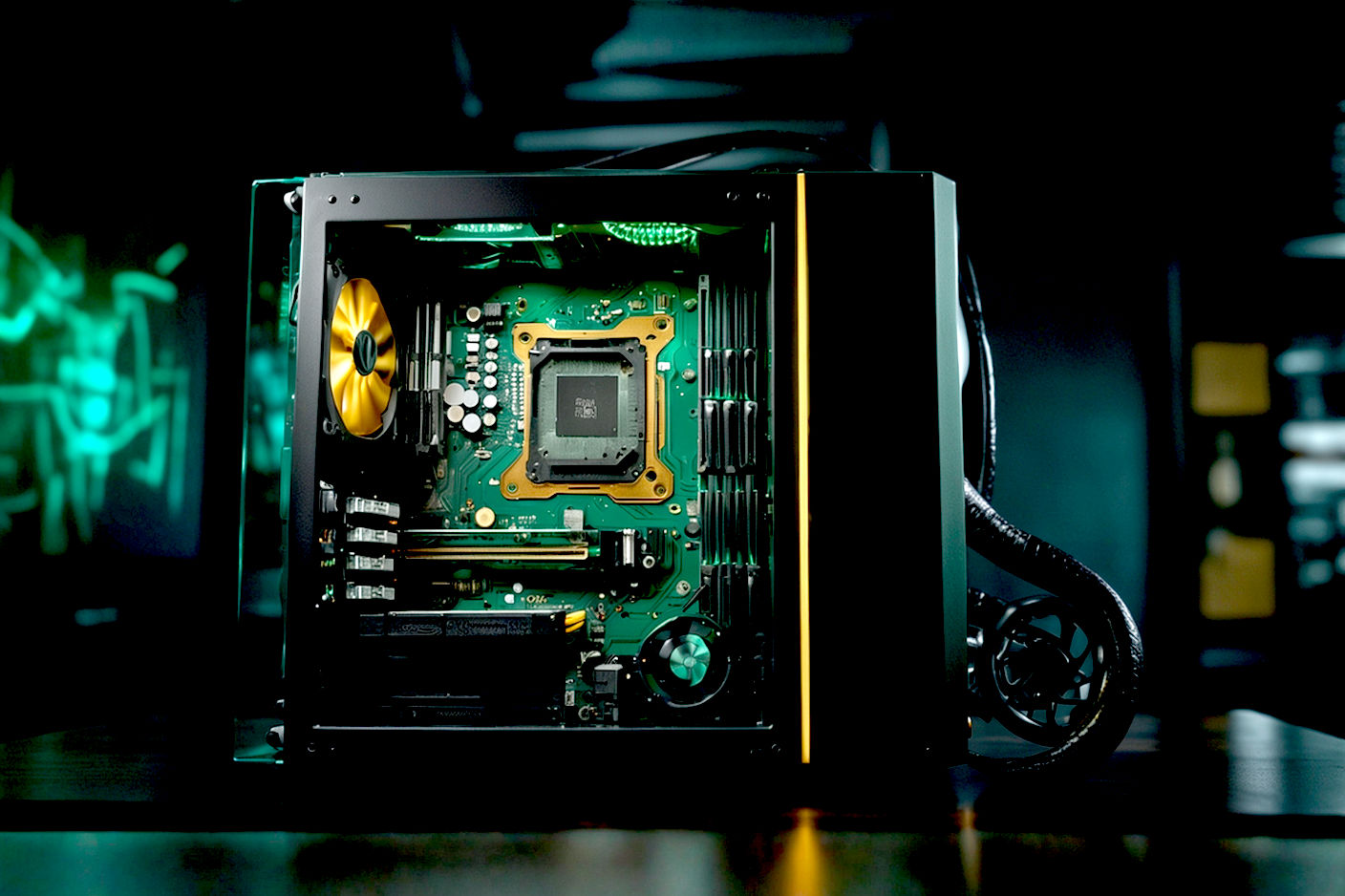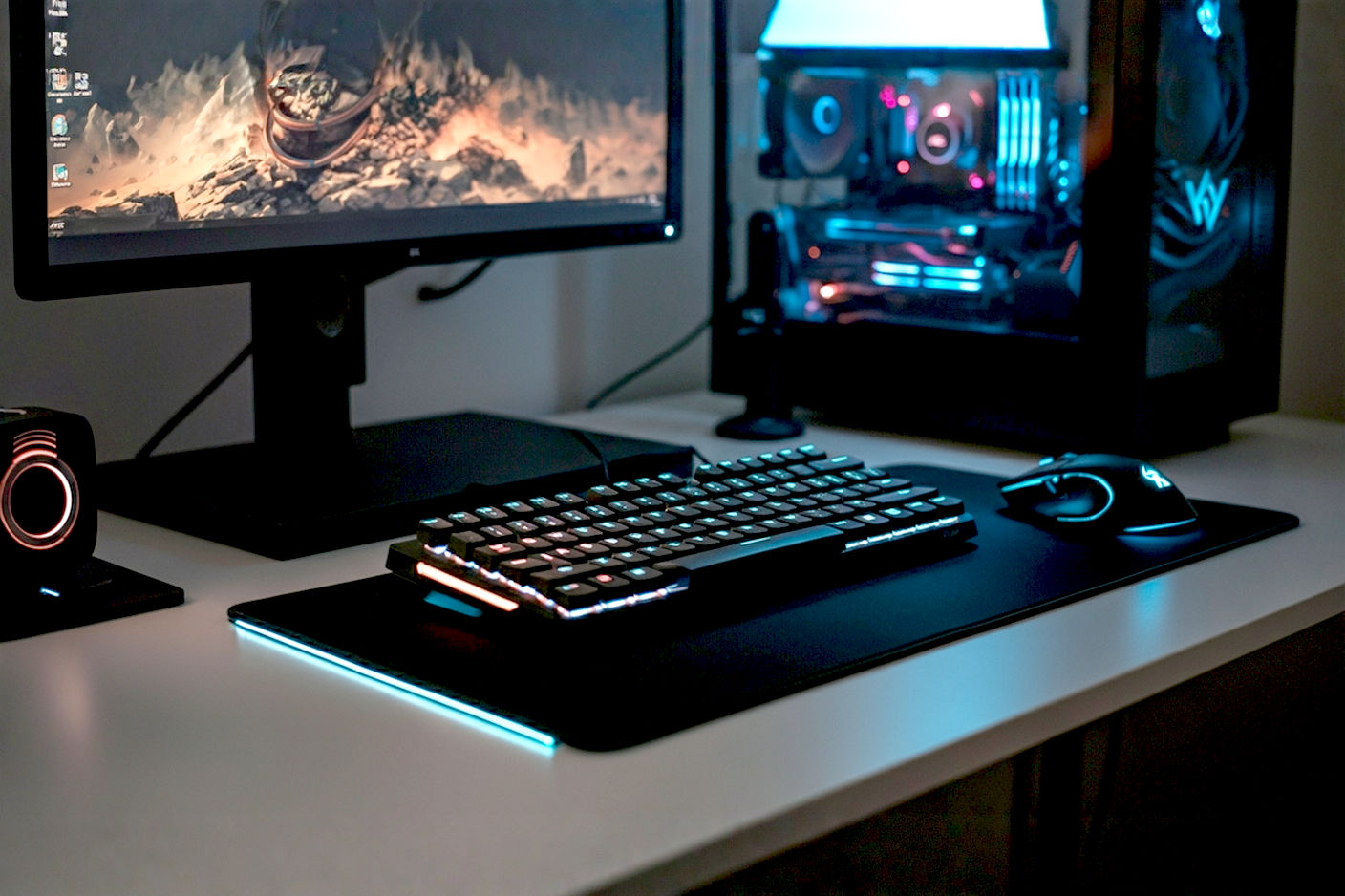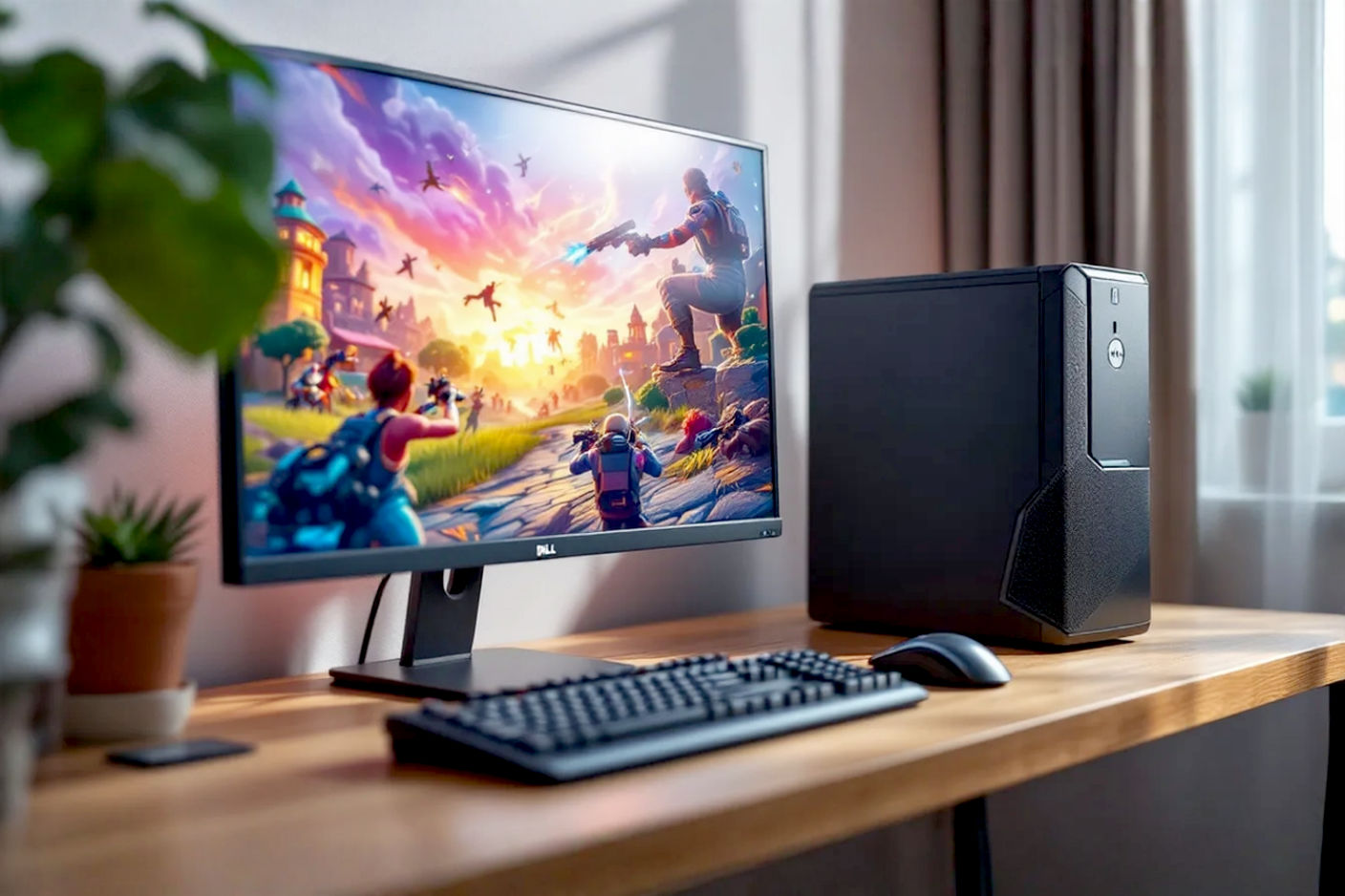This post may contain affiliate links. If you make a purchase through these links, we may earn a commission at no additional cost to you.
Living in a small space doesn’t mean you have to give up on powerful PC gaming. For many, the dream gaming setup involves a massive tower, multiple monitors, and a dedicated room. But what if you don’t have that kind of space? This is where compact gaming PCs come into play. These smaller machines pack serious power into a much smaller footprint, making them an attractive option for apartments, dorm rooms, or anyone looking to save desk space. But are they the right choice for you? Let’s dive deep into the world of compact gaming PCs, exploring their benefits, drawbacks, and everything you need to consider before making a decision.
The Growing Appeal of Small Form Factor Gaming PCs
The traditional image of a gaming PC is a large, imposing tower case. These cases offer plenty of room for components, cooling, and future upgrades. However, they also take up a significant amount of space. As living spaces shrink and minimalist aesthetics gain popularity, the demand for smaller, more discreet gaming setups has grown.
Small Form Factor (SFF) PCs, including compact gaming machines, have seen a surge in popularity over the past decade. This isn’t just about saving space; it’s also about portability (to some extent), design, and integrating a powerful computer into a living area without it dominating the room. Manufacturers have responded by developing smaller motherboards, power supplies, and cases specifically designed for SFF builds. This has made building or buying a compact gaming PC more accessible than ever before.
The appeal lies in the ability to have a high-performance machine that can handle the latest games at high settings, all while fitting neatly on a small desk, on a shelf, or even integrated into an entertainment center. It’s about maximizing performance per square inch.
Understanding Compact Gaming PCs: What Defines Them?
When we talk about compact gaming PCs, we’re generally referring to systems built using smaller motherboard sizes and housed in cases designed to minimize volume. The most common motherboard sizes for compact builds are Mini-ITX and Micro-ATX.
- Mini-ITX: This is the smallest standard motherboard form factor. Mini-ITX boards typically measure 170mm x 170mm (6.7 inches x 6.7 inches). They usually have only one PCIe slot (for the graphics card) and two RAM slots. This size severely limits expansion options but allows for incredibly small case designs.
- Micro-ATX: Slightly larger than Mini-ITX, Micro-ATX boards measure 244mm x 244mm (9.6 inches x 9.6 inches). They offer more expansion slots, typically including multiple PCIe slots and four RAM slots, providing a better balance between size and expandability compared to Mini-ITX, while still being smaller than standard ATX boards.
The case size is the most visible indicator of a compact PC. SFF cases are designed specifically to house these smaller motherboards and components efficiently. They come in various shapes and sizes, from console-like designs to tiny cubes or slim towers. The key characteristic is their significantly reduced volume compared to standard mid-tower or full-tower cases. This reduction in size is the primary benefit, but it also introduces several challenges.
Pros of a Compact Gaming PC for Small Spaces
The advantages of choosing a compact gaming PC are particularly relevant for those with limited room. These benefits go beyond just saving space and can impact aesthetics, portability, and even energy consumption in some cases.
Space Saving and Aesthetics
This is the most obvious benefit. A compact gaming PC takes up significantly less physical space than a traditional tower. This is crucial in small apartments, dorm rooms, or shared living areas where every square inch matters. You can place it on a small desk, tuck it away on a shelf, or even mount some cases behind a monitor.
Beyond just saving space, SFF cases often have a more refined and modern aesthetic compared to bulky towers. Many are designed to blend into a living room setup or complement a minimalist workspace. They can be less imposing and more visually appealing, making your gaming setup feel less like a command center and more like an integrated part of your home. Some cases feature premium materials like aluminum and tempered glass, offering a sleek, high-end look.
Think about the visual impact. A large tower can dominate a small room, making it feel even smaller. A compact PC, on the other hand, can sit discreetly, allowing the rest of your decor to stand out. This is a major plus for those who want a powerful gaming machine without sacrificing their home’s aesthetic.
Increased Portability (Relative)
While not as portable as a gaming laptop, a compact gaming PC is significantly easier to move around than a full-sized desktop. If you frequently attend LAN parties, visit friends, or need to move your setup between rooms, an SFF build is much more manageable.
The reduced size and weight make it easier to pack and transport. You don’t need a massive box or specialized carrying case. A sturdy backpack or a small suitcase can often suffice for the PC itself, making it much more convenient to take your gaming rig on the go. This relative portability opens up possibilities for gaming in different locations without the compromises often associated with gaming laptops (like cost for equivalent performance or thermal throttling).
It’s important to manage expectations here; you’re not going to game on a train like you would with a laptop. But for moving between fixed locations, the difference in effort compared to a full tower is substantial.
Potentially Lower Power Consumption (Depends on Components)
While not a guaranteed outcome, a system built with lower-power components specifically for a compact build can consume less electricity than a high-end, full-sized rig. SFF builds sometimes necessitate choosing components that are more power-efficient to manage heat within the smaller case.
For example, you might opt for a slightly less power-hungry CPU or a graphics card known for good performance-per-watt. While you can still put top-tier components in an SFF case, the thermal constraints might encourage choices that lead to lower overall power draw. This can translate to slightly lower electricity bills over time. However, if you pack the most powerful components into a tiny case, your power consumption might be similar to a larger system, and heat becomes a significant challenge. The potential for lower power consumption is more a result of component selection driven by the SFF form factor’s limitations rather than an inherent property of being small.
Quieter Operation (With Careful Component Selection)
With careful component selection and proper cooling setup, a compact PC can potentially be quieter than a larger one. This might seem counterintuitive, as smaller spaces can sometimes lead to more noise due to restricted airflow. However, the key is careful component selection.
Choosing components known for quiet operation, such as low-noise fans, efficient CPU coolers, and graphics cards with effective passive or semi-passive cooling at idle, can result in a very quiet system. Some SFF cases are also designed with noise dampening in mind. While fitting large, quiet fans might be challenging, optimizing the airflow path and using high-quality, smaller fans can still lead to a less noisy machine than a poorly cooled large tower. It requires research and deliberate choices during the build process.
Cons of a Compact Gaming PC for Small Spaces
Despite the attractive benefits, compact gaming PCs come with significant drawbacks that need careful consideration. These challenges are often directly related to the reduced size and can impact performance, cost, and future-proofing.
Thermal Challenges and Potential for Overheating
This is arguably the biggest challenge with compact gaming PCs. Packing powerful components into a small space generates a lot of heat. Heat is the enemy of performance and component longevity. Without adequate cooling, components can overheat, leading to thermal throttling (where performance is reduced to prevent damage) or even system instability and shutdowns.
SFF cases have limited space for airflow and large heatsinks or radiators. This means you need to be very deliberate about your cooling solution. Air cooling options are often limited to smaller, less effective heatsinks. Liquid cooling, while effective, adds complexity, cost, and takes up valuable space within the case. The fans in an SFF case often have to spin faster to move enough air, which can lead to increased noise levels, counteracting the potential for quieter operation mentioned earlier.
Managing thermals in a compact build requires careful planning, research into component heat output, and often a willingness to invest in premium cooling solutions or compromise slightly on component power. It’s a delicate balancing act to keep temperatures in check.
Limited Upgradeability and Expansion Options
The smaller motherboard sizes (Mini-ITX and Micro-ATX) and limited case space significantly restrict future upgrades and expansion. Mini-ITX boards typically have only one PCIe slot, meaning you can only install one graphics card and have no room for expansion cards like sound cards, capture cards, or additional network adapters. They also usually have only two RAM slots, limiting the maximum amount of RAM you can install compared to boards with four slots.
Micro-ATX offers slightly more flexibility with multiple PCIe slots and often four RAM slots, but case size can still limit the physical size of components you can install. For example, fitting multiple large graphics cards for SLI or CrossFire is usually impossible in an SFF case. Adding extra storage drives (HDDs or SSDs) can also be challenging due to limited drive bays.
This limited upgradeability means that a compact gaming PC might have a shorter lifespan before needing a more significant overhaul or replacement compared to a larger system where you can easily add more RAM, storage, or a second graphics card. You need to choose your initial components carefully, as swapping them out later might be more difficult or impossible depending on the case design.
Higher Cost for Equivalent Performance
Generally speaking, building or buying a compact gaming PC can be more expensive than a traditional tower with equivalent performance. This is due to several factors:
- Specialized Components: SFF cases, Mini-ITX motherboards, and compact power supplies (like SFX or SFX-L PSUs) are often more expensive than their standard ATX counterparts. There’s less competition in the SFF market, and the engineering required to make components smaller and more efficient can drive up costs.
- Premium Cooling: To manage thermals effectively in a small space, you often need to invest in higher-end, more expensive cooling solutions, such as specialized low-profile air coolers or compact liquid coolers.
- Limited Options: The selection of SFF-compatible components is smaller than for standard ATX builds. This can limit your choices and potentially force you into buying more expensive options if you have specific performance targets.
While the price difference might not be astronomical for every build, achieving the same level of performance and thermal management in a compact form factor typically requires a higher budget than a standard-sized PC. You’re paying a premium for the miniaturization and the engineering required to make it work.
More Complex Building and Maintenance
Building a PC in a compact case is generally more challenging than building in a spacious mid-tower. The limited space means components are packed tightly together, making it harder to maneuver your hands, connect cables, and install or remove parts. Cable management, which is crucial for airflow and aesthetics, becomes a much trickier task in an SFF case.
Maintenance, such as cleaning dust filters or replacing a fan, can also be more involved due to the tight layout. Accessing specific components might require removing multiple other parts first. This complexity can be daunting for first-time builders and requires more patience and attention to detail. While not impossible, it’s a less forgiving process than working in a larger case with ample room.
Key Considerations When Choosing a Compact Gaming PC
If you’re leaning towards a compact gaming PC, there are several crucial factors you need to consider to ensure you build or buy a system that meets your needs without encountering major issues. These considerations revolve around balancing size, performance, thermals, and budget.
Size and Form Factor
The first step is deciding how small you really need the PC to be. Are you aiming for the absolute smallest possible footprint (Mini-ITX), or can you accommodate something slightly larger for more flexibility (Micro-ATX)? Research different SFF case sizes and designs. Some cases are designed to be extremely small, while others are merely smaller than a standard tower but still offer decent internal volume.
Consider where the PC will be placed and measure the available space precisely. Don’t forget to account for ventilation – the case will need space around it for air intake and exhaust. Different case layouts (e.g., console style, cube, slim tower) have different footprints and airflow characteristics. Choose a form factor and case size that fits your physical space constraints while also offering enough internal volume to house your desired components and cooling solution.
Cooling Solution
As highlighted earlier, cooling is critical in a compact build. You need to carefully plan your cooling setup based on the heat output of your chosen components, particularly the CPU and GPU.
- Air Cooling: Low-profile CPU coolers are necessary for many SFF cases. Research their thermal performance and compare them to the TDP (Thermal Design Power) of your chosen CPU. Case fans are also essential for moving air through the case. Consider the number and size of fan mounts available in the case and invest in high-quality fans with good static pressure to push air through potentially restrictive spaces.
- Liquid Cooling: All-in-One (AIO) liquid coolers can be very effective in SFF builds, especially for cooling high-end CPUs. However, radiator size and placement are limited by the case design. Ensure the case supports the radiator size of the AIO you plan to use (e.g., 120mm, 240mm). Custom loop liquid cooling is also an option for advanced builders seeking maximum thermal performance and aesthetics, but it adds significant complexity and cost.
Always prioritize cooling in your component selection and case choice. It’s better to slightly underspend on a component to allocate more budget to a robust cooling solution than to have a powerful PC that constantly overheats.
Component Selection (Balancing Power and Heat)
Choosing the right components is a delicate balancing act in a compact build. You need to select parts that offer the performance you need for gaming while also being mindful of their heat output and physical size.
- CPU: Consider CPUs with a lower TDP if possible, or be prepared to invest in a high-performance SFF cooling solution for higher-wattage processors. Some CPUs have “T” variants (e.g., Intel Core i7-13700T) which offer lower power consumption and heat output at the cost of slightly reduced clock speeds.
- GPU: Graphics cards are often the largest and hottest components in a gaming PC. Check the maximum GPU length, height, and width supported by your chosen case. Some SFF cases require ‘mini’ or ‘ITX’ versions of graphics cards, which are shorter. Be aware that these smaller versions might have less robust cooling solutions than their full-sized counterparts.
- Power Supply: SFF cases typically require SFX or SFX-L power supplies, which are smaller than standard ATX PSUs. Ensure the PSU you choose has enough wattage to power your components and is from a reputable brand known for reliability. SFX PSUs can sometimes be louder than ATX PSUs due to smaller fan sizes.
- RAM and Storage: While less critical for thermals, ensure the RAM modules fit under your CPU cooler if using a large air cooler. For storage, M.2 NVMe SSDs are ideal for SFF builds as they are small and don’t require cables, minimizing clutter and improving airflow compared to 2.5-inch SSDs or 3.5-inch HDDs, although you may still need space for at least one SATA drive.
Research component dimensions and thermal characteristics thoroughly before purchasing to avoid compatibility issues and ensure adequate cooling.
Budget
As mentioned, compact gaming PCs can be more expensive for equivalent performance. Set a realistic budget and allocate funds wisely. Be prepared to potentially spend more on the case, motherboard, and cooling solution than you would for a standard ATX build. If budget is a major constraint, you might need to compromise slightly on performance or consider a slightly larger Micro-ATX build to save money on components.
Factor in the cost of specialized SFF components and potentially more expensive cooling when planning your budget. Don’t just look at the price of the CPU and GPU; the supporting SFF infrastructure adds to the overall cost.
Noise Levels
While potential for quiet operation exists, poorly managed thermals in an SFF case can lead to noisy fans. If noise is a concern, research case airflow design, fan options, and component noise levels. Look for reviews that specifically mention acoustics for the case and components you are considering. Investing in high-quality, low-noise fans and a robust cooling solution is key to keeping noise levels down in a compact build. Some SFF cases are designed with noise dampening materials, which can also help.
Different Compact PC Form Factors and Cases
Beyond just Mini-ITX and Micro-ATX motherboards, the world of compact PC cases offers a wide variety of designs and sizes. Understanding these different form factors can help you choose the best fit for your space and needs.
Mini-ITX Cases
These cases are designed for Mini-ITX motherboards and are the smallest option. They come in various styles:
- Console Style: These cases resemble gaming consoles and are designed to fit horizontally in an entertainment center. They are often very slim, which can pose significant challenges for cooling high-end components. Examples include the Silverstone Raven RVZ03 or the Fractal Design Node 202.
- Cube Style: These cases are roughly cube-shaped and offer a bit more internal volume than console-style cases, allowing for slightly larger coolers and easier building. Examples include the Cooler Master Elite 110 or the Thermaltake Core V1.
- Shoebox Style: Taller and deeper than cube cases, these offer more flexibility for components and cooling while still being significantly smaller than a mid-tower. Examples include the NCASE M1 (a popular but often expensive option) or the Dan A4-SFX.
- Slim Tower: These stand vertically but have a very narrow footprint. They are good for placing beside a monitor but can be restrictive for GPU size and cooling.
Choosing a Mini-ITX case requires careful attention to component compatibility lists provided by the case manufacturer. Every millimeter counts in these tiny builds.
Micro-ATX Cases
Micro-ATX cases are designed for Micro-ATX motherboards and offer a compromise between size and expandability. They are larger than most Mini-ITX cases but smaller than standard mid-towers.
- Compact Towers: These look like smaller versions of traditional PC towers. They offer more room for components, multiple storage drives, and better airflow compared to Mini-ITX cases. They can typically accommodate larger CPU coolers and longer graphics cards. Examples include the Cooler Master NR400 or the Fractal Design Meshify C Mini.
- Cube Style: Some Micro-ATX cases also come in a cube format, offering a wider but shorter footprint. These can provide good access for building and decent cooling potential.
Micro-ATX cases are a good option if you need more flexibility for upgrades or want an easier building experience than Mini-ITX, but still need something smaller than a full-sized tower.
Barebone and Pre-built Compact PCs
If building a PC seems too daunting, especially in a compact form factor, consider barebone kits or pre-built compact gaming PCs.
- Barebone Kits: These typically include a case, motherboard, and power supply, sometimes with a basic CPU cooler. You need to add the CPU, RAM, storage, and graphics card yourself. This offers some customization while simplifying the most challenging aspects of SFF building.
- Pre-built Compact Gaming PCs: Many manufacturers offer pre-configured compact gaming systems. This is the easiest option, as the system is ready to go out of the box. However, customization options might be limited, and you might pay a premium for the convenience. Research reviews carefully to ensure the pre-built system has adequate cooling and uses standard, upgradeable components where possible.
These options can be a good entry point into compact PC gaming for those who are less comfortable with the intricacies of SFF building.
Building vs. Buying a Compact Gaming PC
Deciding whether to build your own compact gaming PC or buy a pre-built one is a significant choice with implications for cost, customization, and complexity.
Building Your Own
Pros:
- Maximum Customization: You have complete control over every component, allowing you to tailor the PC precisely to your performance needs, budget, and aesthetic preferences.
- Potentially Lower Cost: Buying components individually can sometimes be cheaper than buying a pre-built system with equivalent specifications.
- Learning Experience: Building a PC is a valuable skill and provides a deeper understanding of how the hardware works.
- Easier to Upgrade (Later): While SFF has limitations, building yourself means you know exactly how the system is put together, making future component swaps easier within the case’s constraints.
Cons:
- Complexity: SFF builds are more challenging than standard builds due to tight space and cable management.
- Time Consuming: Researching components, finding compatible parts, and the actual assembly process take time.
- Troubleshooting: If something doesn’t work, you are responsible for diagnosing and fixing the issue.
- Potential for Mistakes: Small errors during assembly can damage components.
Buying a Pre-built
Pros:
- Convenience: The PC arrives ready to use out of the box.
- Time Saving: No need to spend hours researching and assembling.
- Warranty and Support: Pre-built systems come with a warranty, and you have technical support if something goes wrong.
- Guaranteed Compatibility: The manufacturer ensures all components work together.
Cons:
- Limited Customization: You are limited to the configurations offered by the manufacturer.
- Potentially Higher Cost: You often pay a premium for the convenience and warranty.
- Component Quality: Some pre-built systems might use lower-quality components (like power supplies or motherboards) to save costs.
- Bloatware: Pre-built systems often come with pre-installed software you don’t need.
- Harder to Upgrade (Sometimes): Some pre-built cases or component layouts can make future upgrades difficult.
For compact gaming PCs, the complexity of building is a bigger factor than with standard builds. If you’re not comfortable with intricate assembly in tight spaces, a pre-built system or barebone kit might be a more suitable option. However, if you value customization and are willing to tackle the challenge, building your own offers greater control and potentially better value.
Performance Expectations and Realistic Goals
It’s absolutely possible to build a very powerful gaming PC in a compact form factor. You can fit high-end CPUs and graphics cards into SFF cases. However, you need to set realistic performance expectations, especially regarding thermal performance under sustained load.
While a compact PC might achieve similar benchmark scores to a larger PC with the same components in short bursts, it might experience more significant thermal throttling during long gaming sessions. This means the components get hot and reduce their clock speeds to prevent damage, leading to a drop in performance.
- Thermal Throttling Explained: Modern CPUs and GPUs have built-in thermal monitoring. When they reach a certain temperature threshold (the thermal limit), they automatically reduce their power consumption and operating frequency (clock speed). This lowers the temperature but also reduces the number of calculations they can perform per second, resulting in lower frame rates in games or slower performance in demanding applications. In a compact case with less effective cooling, components are more likely to hit these thermal limits sooner and more frequently.
To mitigate this, you might need to:
- Choose components that are known for good thermal efficiency.
- Invest in the best possible SFF cooling solution your case can accommodate.
- Consider undervolting your CPU or GPU (reducing the voltage they receive) to lower heat output with minimal performance loss. This is an advanced technique.
- Accept that sustained peak performance might be slightly lower than in a larger, better-cooled system.
Set realistic goals based on the thermal limitations of the SFF form factor. While you can play the latest games, achieving consistently high frame rates for extended periods might require compromises or significant investment in cooling.
The Verdict: Is a Compact Gaming PC Right for You?
After weighing the pros and cons, the decision of whether a compact gaming PC is right for your small space comes down to your priorities and willingness to navigate the challenges.
A compact gaming PC is likely a good fit if:
- Space is your absolute top priority. You live in a small apartment, dorm, or have limited desk space and need a powerful PC that won’t dominate the room.
- Aesthetics matter. You prefer a clean, minimalist look and want a PC that blends into your living space.
- Relative portability is a plus. You need to move your PC occasionally for LAN parties or visiting friends/family.
- You are comfortable with the potential for slightly higher costs for equivalent performance. You understand that miniaturization comes at a premium.
- You are willing to research and invest in effective cooling solutions. You understand the thermal challenges and are prepared to address them.
- You are comfortable with limited upgradeability. You plan to use the current components for a significant period or are comfortable with more involved upgrades down the line.
- You are comfortable with potentially more complex building or are willing to buy a pre-built system.
A compact gaming PC might NOT be the best fit if:
- Maximum raw performance and sustained peak performance are your absolute top priorities. You need every possible frame per second and don’t want to deal with potential thermal throttling.
- Budget is your primary concern. You want the most performance for your money, and the SFF premium is not appealing.
- Easy upgradeability is crucial. You plan to frequently swap components, add expansion cards, or install multiple storage drives.
- You are uncomfortable with the potential for higher noise levels under load.
- You are a first-time builder looking for the easiest possible assembly experience.
- You need extensive connectivity options that might not be available on smaller motherboards.
Ultimately, a compact gaming PC is a trade-off. You gain significant space savings and potentially a more aesthetically pleasing setup, but you compromise on thermal performance, upgradeability, and often cost. For many in small spaces, the benefits outweigh the drawbacks, provided they go into it with realistic expectations and a willingness to address the specific challenges of the form factor.
Do your research, plan your build carefully (or choose a reputable pre-built system), prioritize cooling, and you can absolutely have a powerful gaming machine that fits perfectly into your small space. The world of SFF PCs is constantly evolving, with new cases and components designed to push the boundaries of performance in a small footprint.






